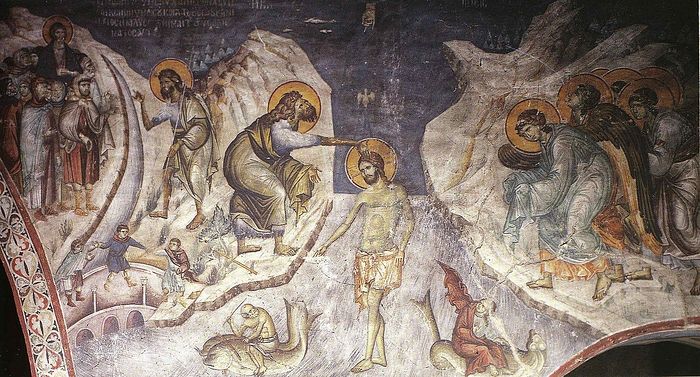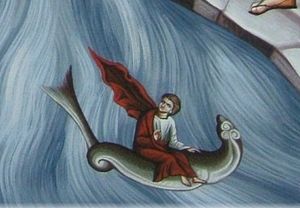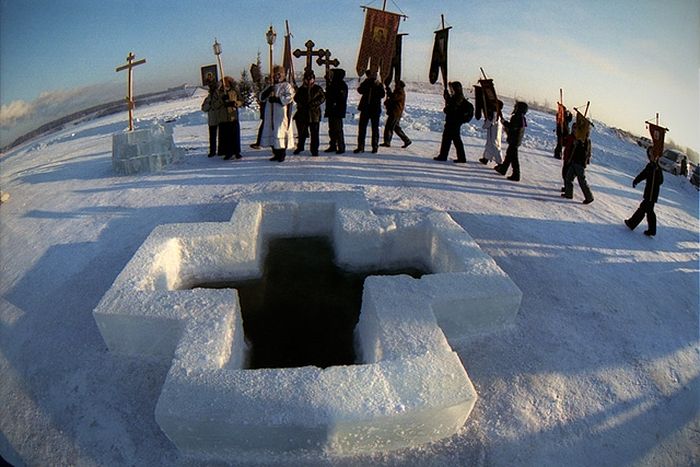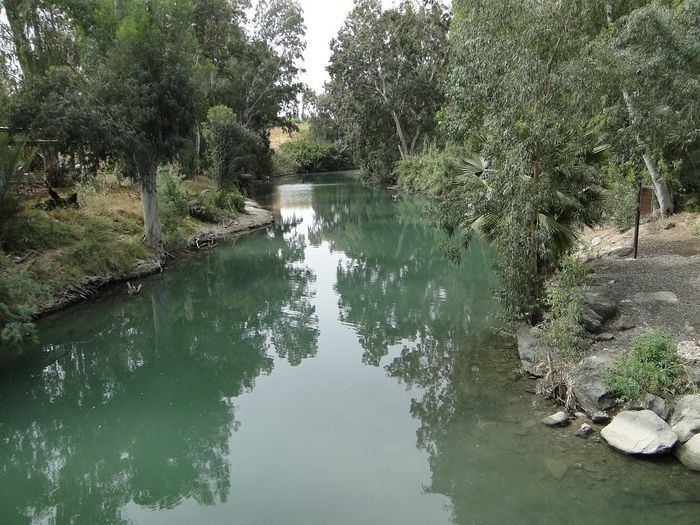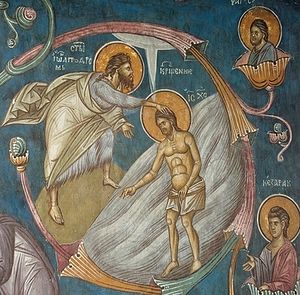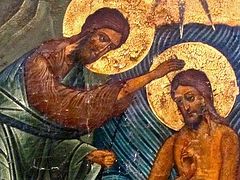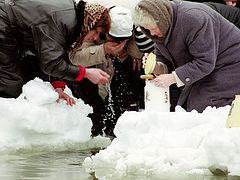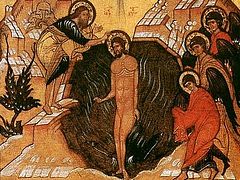What event reminds us of the Baptism of Christ? Why does the Nicea-Constantinople Creed mention only one sacrament—that of Baptism? Why is the feast of Baptism also called the Theophany? And how should fulfil our baptismal promises?
This is what we read in the Lamentations: It is of the Lord's mercies that we are not consumed, because His compassions fail not. They are new every morning: great is Thy faithfulness (Lam. 3:22-23). That is, by pouring out His blessings on those who pray in the morning, the Almighty in some sense creates the world afresh and fully renews it!
The Bible knows two worlds—those of the Old Testament and the New Testament.
During the creation of the first world …darkness was upon the face of the deep. And the Spirit of God moved upon the face of the waters (Gen. 1:2).
“In my opinion, the authority belonging to the liquid element [that is, water—Fr. O. S.] requires examination. As a matter of fact, it is amply attested, and indeed from the beginning. For it is one of those elements which, before the world was created at all, rested with God in a form as yet crude. In the beginning, Scripture says, God made heaven and earth. But the earth was invisible and in disorder, and there was darkness over the deep, and the spirit of the Lord moved over the waters. (Gen. 1:1-2). It is your duty, O man, to hold in reverence, in the first place, the age of the waters, because their substance is ancient, in the second place their worth, as the home of the Divine spirit [that is, the grace of God in action—Fr. O. S.], more pleasing assuredly than the other elements at that time. For darkness was as yet entirely shapeless, being without the ornament of the stars, and the deep was forbidding, the earth was unready and the sky was unformed; water alone, the ever perfect matter, joyous, simple, unmixed in its very essence, provided a worthy vehicle for God. Again, later, the arrangement of the world took form for God, the waters somehow exercising a regulative function1.”
Likewise, during the creation of the second world, we see the Son of God standing amid the streams of the Jordan, and the Holy Spirit hovering over His head and blessing the waters of the new world (cf. 3:16-17). And in this case the waters by their mobility indicate possible good changes from God, for His mercy has not run out.
“But it will be enough at the outset to seize upon those features in which the essential character of Baptism is recognized. Its first aspect is that by which even in those days the very attitude gave an early indication of the manner of Baptism, namely that the spirit of God, which from the beginning moved upon the waters, would rest over the waters of Baptism2.” “For it is the habit of vipers and asps and even basilisks to haunt dry and waterless spots. But we little fish, like our Fish [the first letters of the five words, “Jesus Christ, Son of God, Savior,” in Greek, spell the common noun meaning “a fish”] Jesus Christ, are born in water, and it is only by remaining in water that we are safe3.”
The Baptism of Christ was an epoch-making event, when the Son of God called on us to fulfil all righteousness (Mt. 3:15), according to the will of Jesus Christ (cf. Mt. 28:19), through the work of the Holy Spirit (cf. Mt. 3:16), before the overshadowing glory of God the Father (cf. Mt. 3:17). It is a custom among Russian people to immerse themselves into the water on this feast, as if experiencing the miracle of their Baptism over and over again4. At the same time, we don’t forget that Baptism is not the putting away of the filth of the flesh, but the answer of a good conscience toward God (1 Pet. 3:21).
“Moreover, Peter himself, showing and vindicating the unity [of the Church—Fr. O. S.], has commanded and warned us that we cannot be saved, except by the one only Baptism of one Church. <…> For as, in that Baptism of the world in which its ancient iniquity was purged away, he who was not in the Ark of Noah could not be saved by water, so neither can he appear to be saved by Baptism who has not been Baptized in the Church which is established in the unity of the Lord according to the sacrament of the one ark5.”
Thus, every time we are celebrating the Baptism of the Lord at church, we remember the baptismal vows that we made (or our godparents made on behalf of us) in front of our baptismal font. The essence of these vows is that we “renounce satan, and all his works, and all his angels, and all his service, and all his pride”6 and then unite ourselves to Christ7.
The crossing of the Red Sea by the Israelites, led by the Holy Prophet and God-Seer Moses during their Exodus from Egypt, signified the deliverance from the power of devil, sin, and fear of death. This was completed by the entry into the Promised Land through crossing the Jordan River under the command of Joshua. In both cases we see the dividing line between the Egyptians and the people of God, between Egypt and the Holy Land, between the baptized and the unbaptized.
And the last dividing line of this kind will be the exodus from the last “Babylon” and “Egypt” in the times of the antichrist. Babylon the great is fallen, is fallen, and is become the habitation of devils, and the hold of every foul spirit, and a cage of every unclean and hateful bird. For all nations have drunk of the wine of the wrath of her fornication, and the kings of the earth have committed fornication with her, and the merchants of the earth are waxed rich through the abundance of her delicacies. And I heard another voice from heaven, saying, Come out of her, my people, that ye be not partakers of her sins, and that ye receive not of her plagues (Rev. 18:2-4).
Thus, the separation from the forces of evil is the renunciation of “satan, and all his works, and all his angels, and all his services, and all his pride”; and the aim of this separation is unity with Christ.
Laying particular emphasis on the role of the Church sacraments, Christians from ancient times linked them to different stages of the human life—and we find the confirmation to this in the texts of the New Testament.
The sacrament of Baptism corresponds to the human birth. Jesus answered: Verily, verily, I say unto thee, Except a man be born of water and of the Spirit, he cannot enter into the Kingdom of God (Jn. 3:5).
Therefore, the sacrament of Chrismation which is performed right after Baptism, signifies the spiritual being’s growth towards salvation. But we are bound to give thanks alway to God for you, brethren beloved of the Lord, because God hath from the beginning chosen you to salvation through sanctification of the Spirit and belief of the truth (2 Thess. 2:13).
But since a being born of the spirit needs food and drink in order to grow, the sacrament of the Eucharist (Holy Communion) gives us all that we need for this purpose as well. For My flesh is meat indeed, and My blood is drink indeed (Jn. 6:55).
The sacrament of Holy Matrimony is intended to regulate the movements of the flesh in a human being who is spiritually born and to help fulfil the commandment to bear children (a functional purpose). But if they cannot contain, let them marry: for it is better to marry than to burn (1 Cor. 7:9); Be fruitful, and multiply, and replenish the earth (Gen. 1:28).
Since as a result of the Fall all organisms are prone to illness, the sacrament of Holy Unction is a healing sacrament. Is any sick among you? Let him call for the elders of the church; and let them pray over him, anointing him with oil in the Name of the Lord (Jam. 5:14).
Likewise, the sacrament of confession heals sick human souls. Then said Jesus to them again, Peace be unto you: as My Father hath sent Me, even so send I you. And when He had said this, He breathed on them, and saith unto them, Receive ye the Holy Ghost: Whose soever sins ye remit, they are remitted unto them; and whose soever sins ye retain, they are retained (Jn. 20:21-23).
The sacrament of Ordination (Holy Orders), like the Holy Matrimony, is an instrumental one. Its purpose is functional—to give spiritual instructions to the people of God (an educational ministry) and make them participants of the grace of the Church sacraments (a saving and sanctifying ministry). Neglect not the gift that is in thee, which was given thee by prophecy, with the laying on of the hands of the presbytery (1 Tim. 4:14); Take heed unto thyself, and unto the doctrine; continue in them: for in doing this thou shalt both save thyself, and them that hear thee (1 Tim. 4:16).
Thus, the repeated8 and non-repeated9 sacraments give people all that they need for salvation. Yet there is only one gateway to the sacraments of the Church—and it is Baptism. That is why it is the only sacrament mentioned in the Nicea-Constantinople Creed: “I acknowledge one Baptism…”
After our physical death sacramental life will be impossible, so we believe that the state of our souls won’t change in eternity. Therefore judge nothing before the time, until the Lord come, Who both will bring to light the hidden things of darkness [that is, in the nether regions—Fr. O. S.], and will make manifest the counsels of the hearts [that took place during our time on earth—Fr. O. S.]: and then shall every man have praise of God (1 Cor. 4:5).
It is crystal clear that Christ Himself didn’t need any rites or sacraments. Then cometh Jesus from Galilee to Jordan unto John, to be baptized of him. But John forbad Him, saying, I have need to be baptized of Thee, and comest Thou to me? And Jesus answering said unto him, Suffer it to be so now: for thus it becometh us to fulfil all righteousness (Mt. 3:13-15). The call to fulfil all righteousness is meant to teach us not to neglect the sacramental life of the Church.
“While the Lord approves His servant’s faithful obedience, He shows the sacrament of His Divine economy by saying, Suffer it to be so now: for thus it becometh us to fulfil all righteousness. By this He demonstrates that the real truth is that the Lord and Teacher Himself should fulfil the whole sacrament of our salvation in Himself. Therefore, the Lord wished to be baptized not for Himself but for us in order to fulfil all righteousness. It is just that anyone who teaches others something should first do it himself. So, since the Lord came as the Teacher of the human race, He willed to show by His example what should be done so that the disciples could follow their teacher and the servants could follow their master10.”
This event, the Baptism of the Lord, is also called the Theophany because the man John the Baptist was the first to contemplate the mystery of the Triune God so clearly. It is a mystery that man would have never found by logic, a mystery to which the following famous words of the early theologian Tertullian can be applied: “I believe because it is absurd” (“Credo quia absurdum”). That is, it is something that is incomprehensible, illogical, irrational and not deducible rationally.
The Forerunner saw the Son of God, standing amid the streams of the Jordan, in a particular way; saw the Spirit of God descending like a dove in a particular way; heard a voice from heaven (of God the Father) in a particular way. St. John the Baptist was the first man to be found worthy of being illuminated by the Trinitarian light of the Triune God so clearly.
This is how Blessed Jerome of Stridon described the Baptism of the Lord: “The mystery of the Holy Trinity is revealed in the Baptism: the Lord is baptized; the Holy Spirit descends in the form of a dove; and the voice of the Father bearing testimony to the Son is heard. And the heaven is opened not through the movement of the visible elements but for the spiritual vision; Ezekiel spoke about it at the beginning of his book as well, that it was opened. And the dove landed on Jesus’s head…11”
Thus, the Forerunner of the Lord was the first to contemplate the mystery of the Trinity—the mystery that makes us Christians.
The Holy Trinity is mentioned quite many times in the texts of both the Old and New Testaments12.
Divine love, of which Apostle John said that God is love (1 Jn. 4:8), is not self-love. Otherwise God would be the source of egoism.
On the contrary, denying that God is alone in His love, the Church has always insisted that God Himself is love—the love of the Three Persons. God the Father loves God the Son, God the Son loves God the Father, and both the Father and the Son dwell in the love of the Holy Spirit. All three Persons of the Holy Trinity dwell in love (the Trinity is the essential love). Isn’t it this love to which we are called in the Gospel: That they may be one, even as we are one (Jn. 17:22)? Blessed Augustine wrote: “If love, with which the Father loves the Son and the Son loves the Father, inexpressibly reveals their unity, wouldn’t it be most appropriate to call the Holy Spirit, Who is common to both, love itself?”13 As St. Gregory the Theologian taught: “The Holy Spirit Himself is love14.” And, at the same time, Blessed Augustine insisted: “Inasmuch as the Father, the Son, and the Holy Spirit are called Wisdom, and not three Wisdoms but one, I don’t understand why the Father, the Son, and the Holy Spirit cannot be called Love, and moreover one Love all together?”15
It is obvious that love in God can be discerned in relation to the very essence of God and to the Person (ὑπόστᾰσις) alike. In relation to the Person it (the word “Love”) is the proper Name of the Holy Spirit just as the “Word” (λόγος) is the proper Name of the Son as a Person.
It is through the Holy Spirit that we participate in this Divine love, as Apostles Paul and Peter put it: Because the love of God is shed abroad in our hearts by the Holy Ghost which is given unto us (Rom. 5:5); According as His divine power hath given unto us all things that pertain unto life and godliness, through the knowledge of Him that hath called us to glory and virtue: Whereby are given unto us exceeding great and precious promises: that by these ye might be partakers of the divine nature, having escaped the corruption that is in the world through lust (2 Pet. 1:3-4).
Persevering in not recognizing any other movement in God, the Church has insisted that in the act of Divine love the Son of God is eternally begotten from God the Father and the Holy Spirit eternally proceeds from Him.
St. John, the Baptizer of the Savior, was the seer of that mystery of the Theophany on the day of the Baptism of the Lord.
And all of us, who need to renew our baptismal promises, grow in the grace of God and love for Him, contemplating with our spiritual eyes this mystery of the Theophany in the Baptism of the Lord. For if these things be in you, and abound, they make you that ye shall neither be barren nor unfruitful in the knowledge of our Lord Jesus Christ (2 Pet. 1:8). That is, growing in love for God and our neighbors, turning away from diabolical pride and egoism, we can keep our baptismal promises to the fullest extent possible. To unite with Christ means to become like the love to which the Son of God bore witness by saying, I and My Father are one (Jn. 10:30); and further, That they all may be one; as Thou, Father, art in Me, and I in Thee, that they also may be one in Us: that the world may believe that Thou hast sent Me (Jn. 17:21).
We begin each prayer rule and each Church sacrament with the words: “In the Name of the Father, and of the Son, and of the Holy Spirit”, addressing all three Persons of the Holy Trinity.
This is the call for unity of Divine love!...

